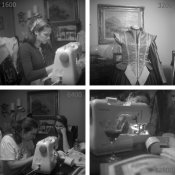ntenny
Subscriber
I've had fairly good luck with Tri-X in Donald Qualls's "Super Soup" developer, a mixture of Dektol, HC-110, ascorbic acid, and sodium carbonate. He gets something like EI 6400-12800 with a 15-minute developing time; I've been using 12 minutes for EI 3200. The results seem much better than they "should" be, in terms of grain, contrast, and tonality; not "it doesn't look pushed" better, but certainly "it doesn't beat you over the head with grain the size of city blocks" better.
Unfortunately, I have an inexplicable problem loading Tri-X in 120 onto reels, and I was losing one or two frames out of every roll, so I thought I'd try the soup with HP5+ and see what kind of speed I thought was workable. I shot a roll of 12 exposures, 3 each at EI 1600, 3200, 6400, and 12800, and developed for 15 minutes with vigorous agitation every 30 seconds.
The attachment shows one frame of each speed, straight out of the scanner. It's pretty clear that 12800 is too ambitious, as I expected, but the other three seem quite usable---6400 loses some shadow detail and would probably be too grainy for big enlargements, though. 3200 seems to be the sweet spot. 1600 is kind of flat but not disastrous, and might print better than it scanned.
There are a few more photos, in postprocessed form, at http://www.flickr.com/photos/ntenny/sets/72157620654443216/.
Considering the extreme speeds, I think these results are pretty good. It's certainly a usable combination for "available darkness" shooting.
-NT
Unfortunately, I have an inexplicable problem loading Tri-X in 120 onto reels, and I was losing one or two frames out of every roll, so I thought I'd try the soup with HP5+ and see what kind of speed I thought was workable. I shot a roll of 12 exposures, 3 each at EI 1600, 3200, 6400, and 12800, and developed for 15 minutes with vigorous agitation every 30 seconds.
The attachment shows one frame of each speed, straight out of the scanner. It's pretty clear that 12800 is too ambitious, as I expected, but the other three seem quite usable---6400 loses some shadow detail and would probably be too grainy for big enlargements, though. 3200 seems to be the sweet spot. 1600 is kind of flat but not disastrous, and might print better than it scanned.
There are a few more photos, in postprocessed form, at http://www.flickr.com/photos/ntenny/sets/72157620654443216/.
Considering the extreme speeds, I think these results are pretty good. It's certainly a usable combination for "available darkness" shooting.
-NT









 I used a (meterless) Rolleiflex for this roll; I just metered at 1600 using a DSLR, then adjusted by one more stop for each subsequent set of shots. The room has pretty consistent lighting---basically, there's a "bright" area, a "medium" area, and a "dim" area, all about a stop apart---so there wasn't that much information to keep in my head.
I used a (meterless) Rolleiflex for this roll; I just metered at 1600 using a DSLR, then adjusted by one more stop for each subsequent set of shots. The room has pretty consistent lighting---basically, there's a "bright" area, a "medium" area, and a "dim" area, all about a stop apart---so there wasn't that much information to keep in my head.


